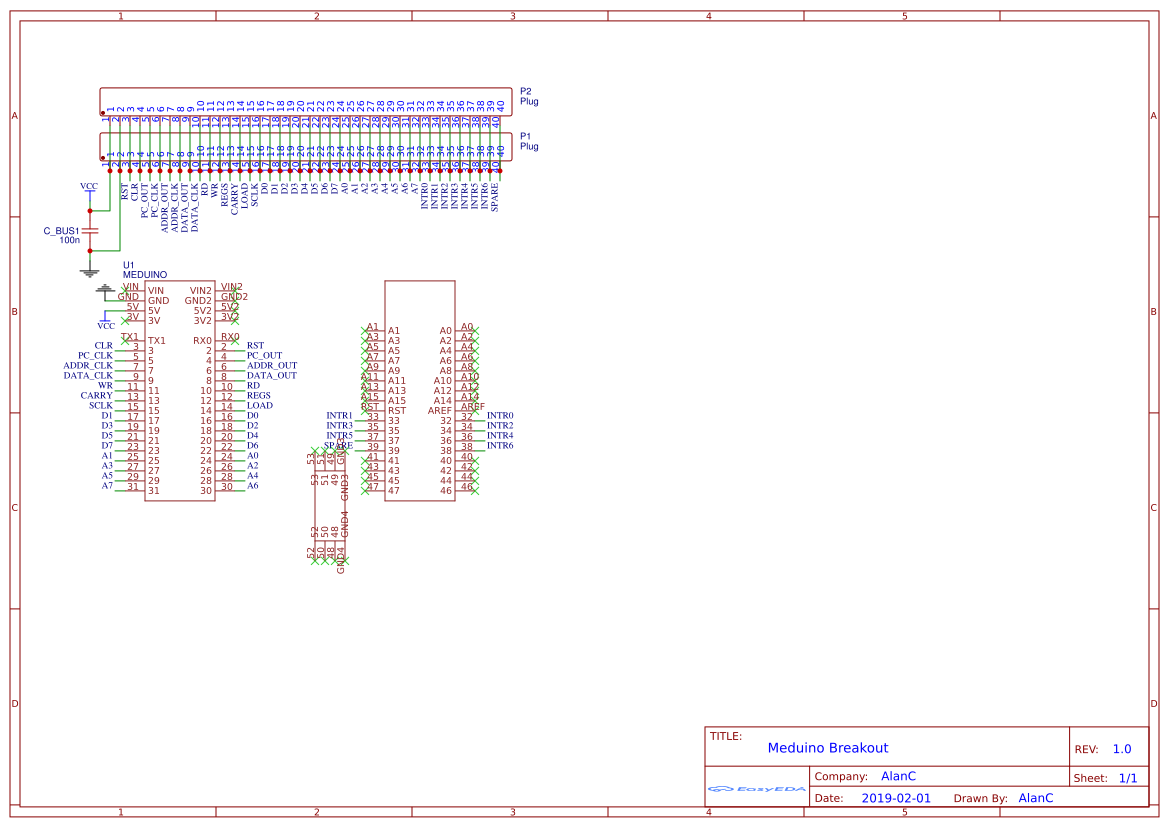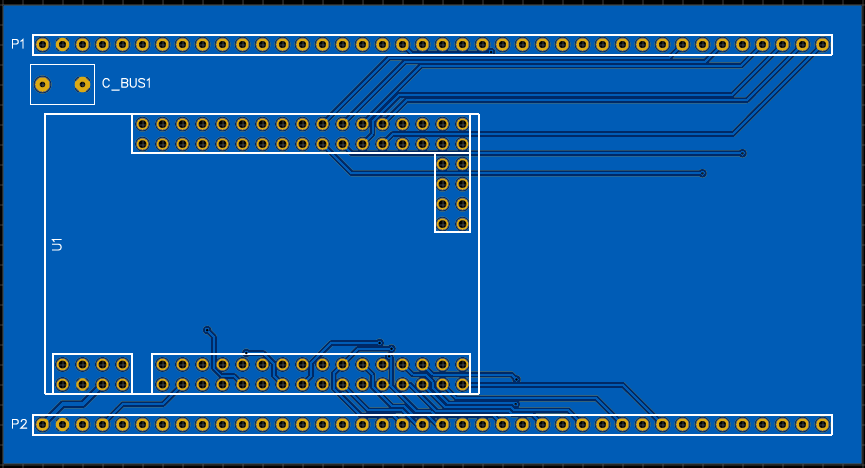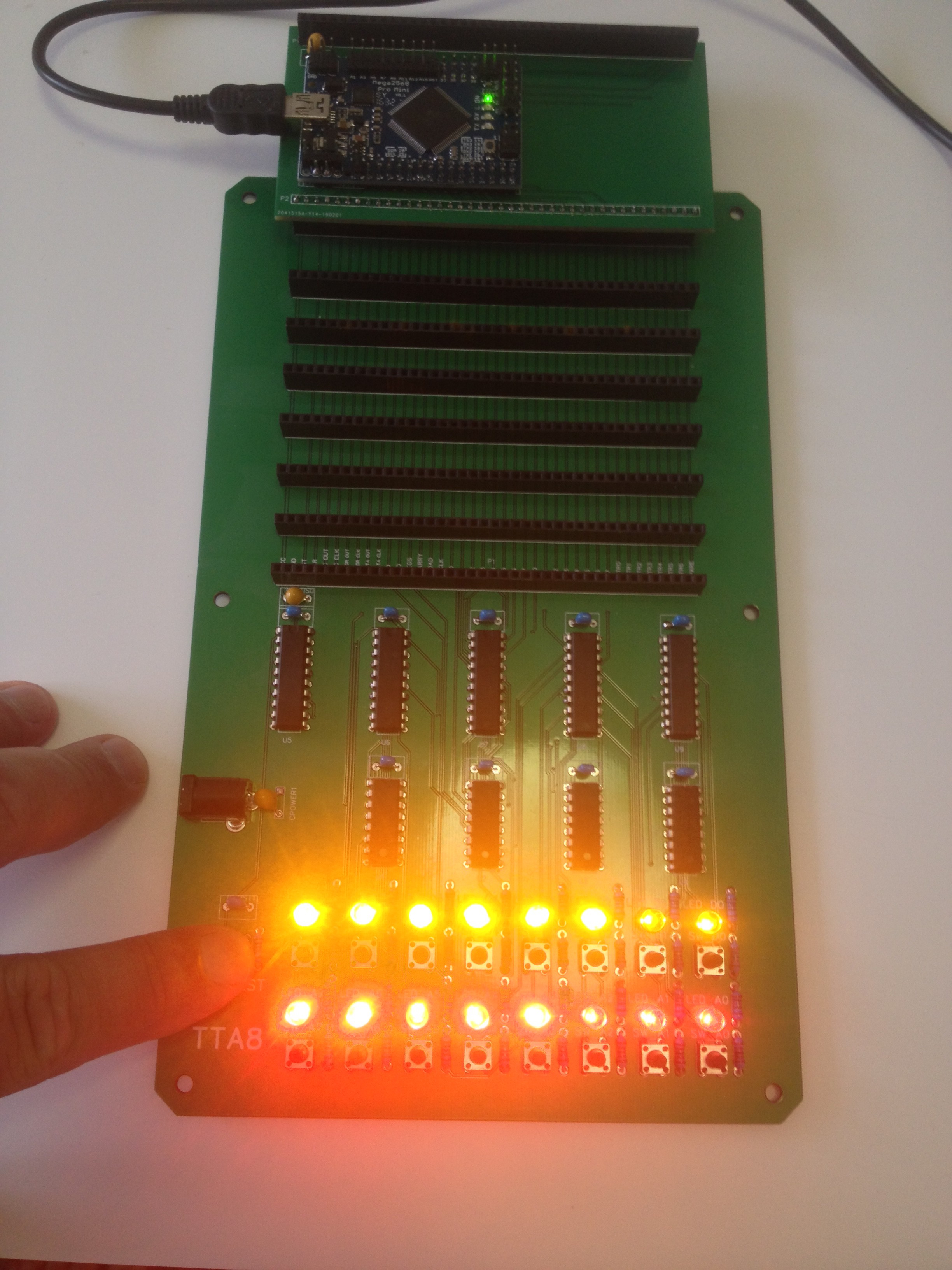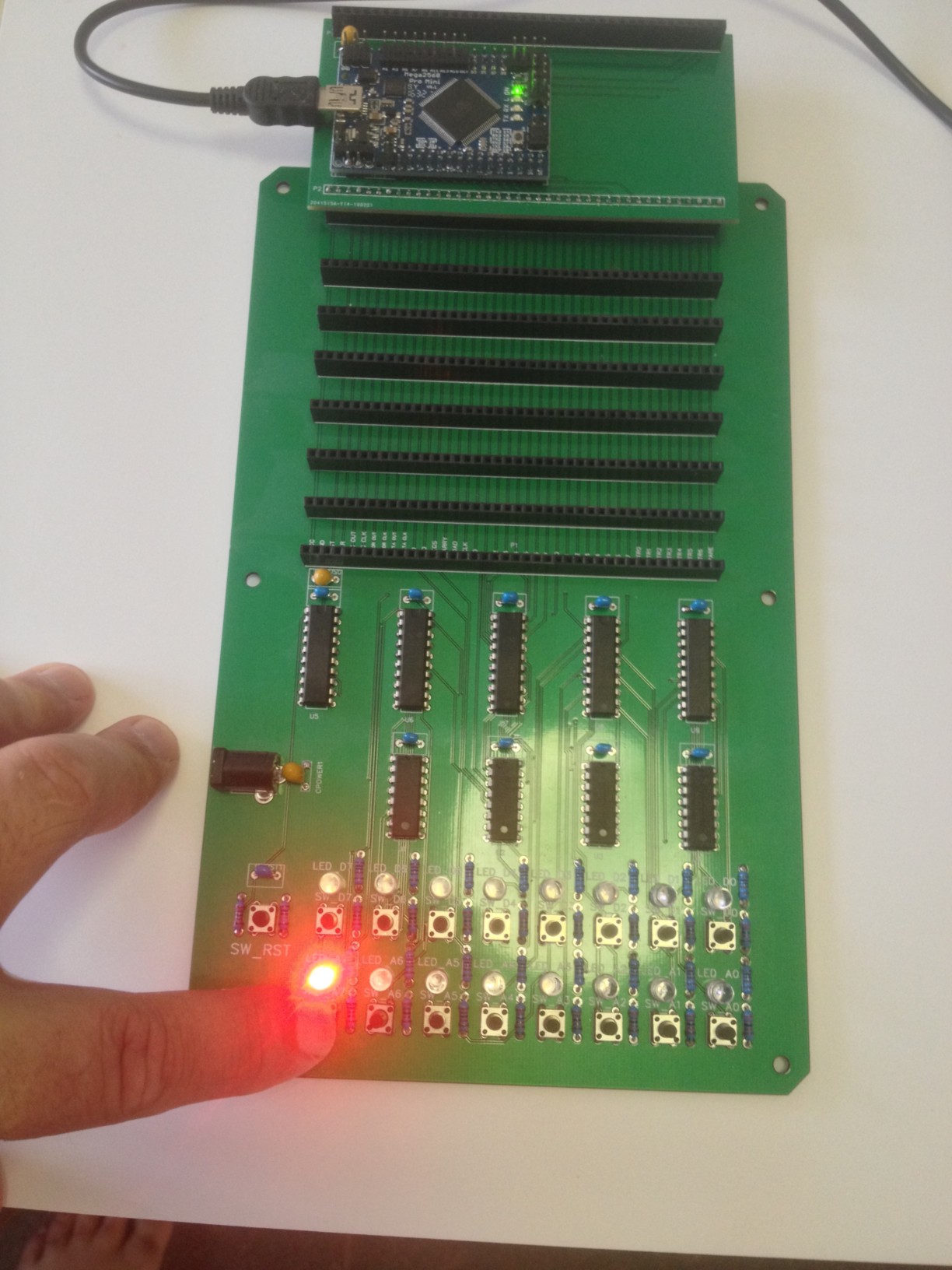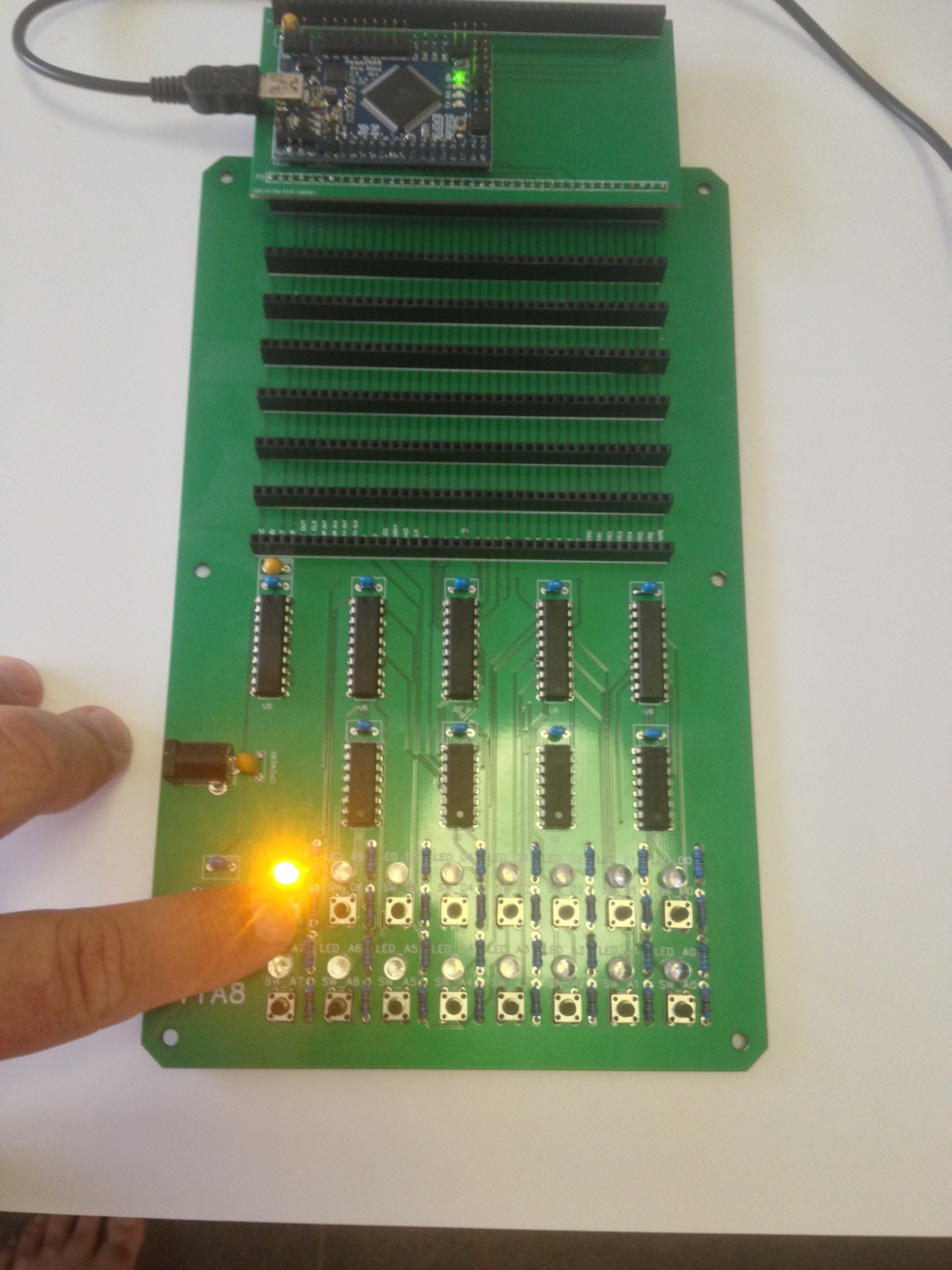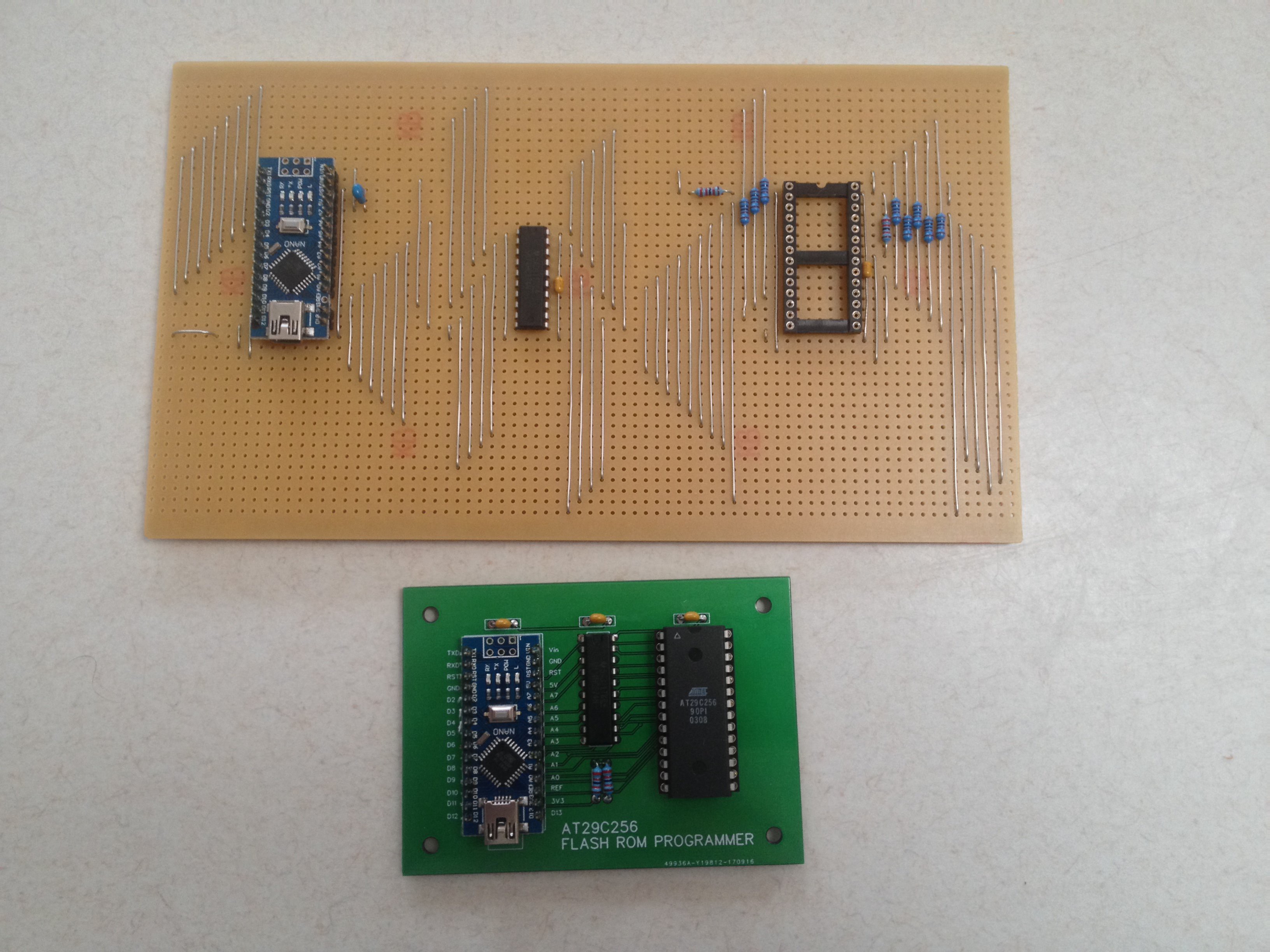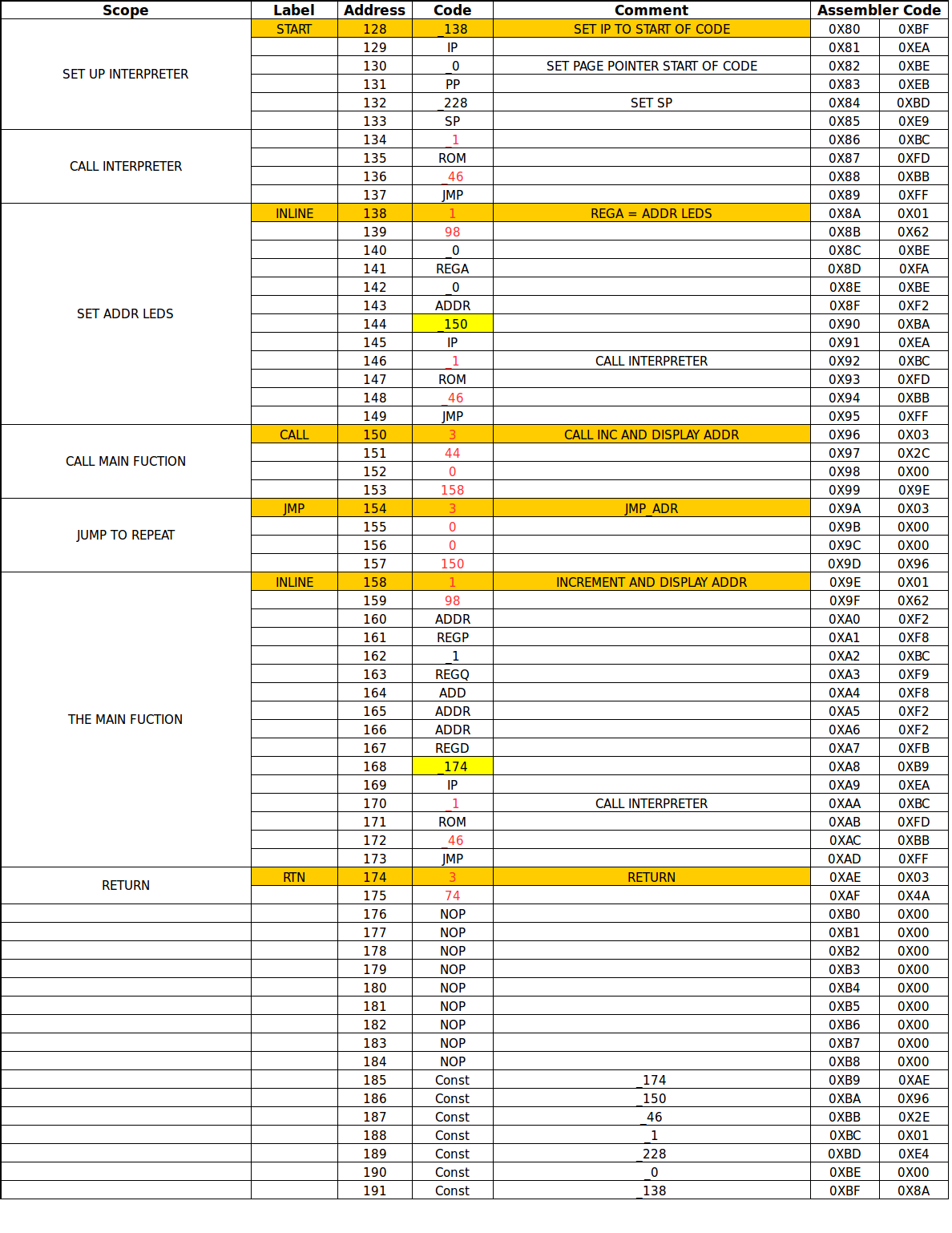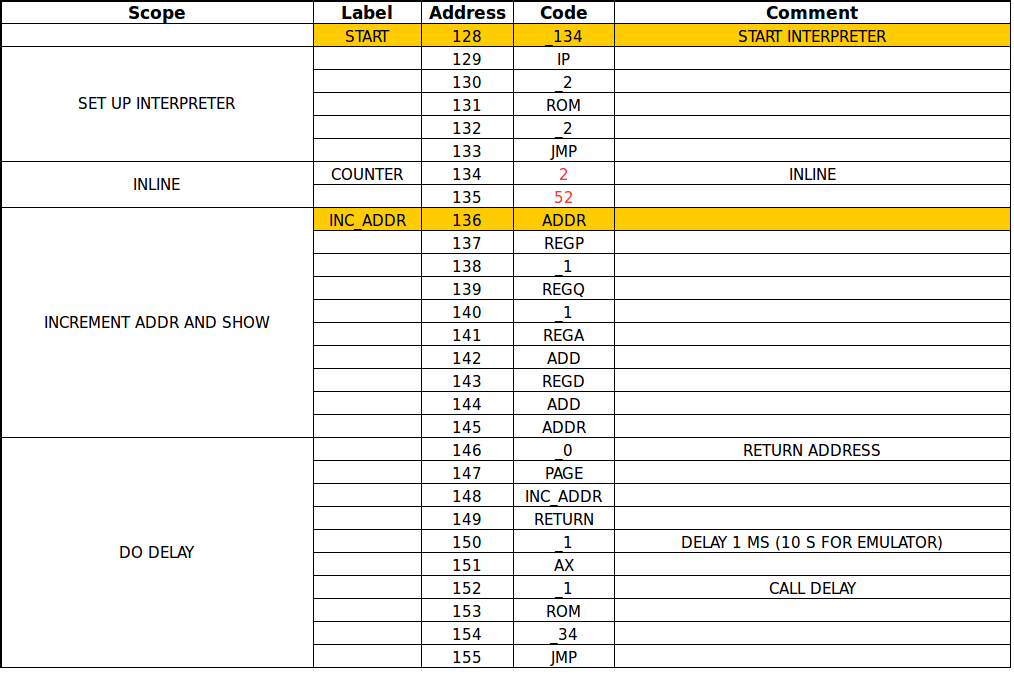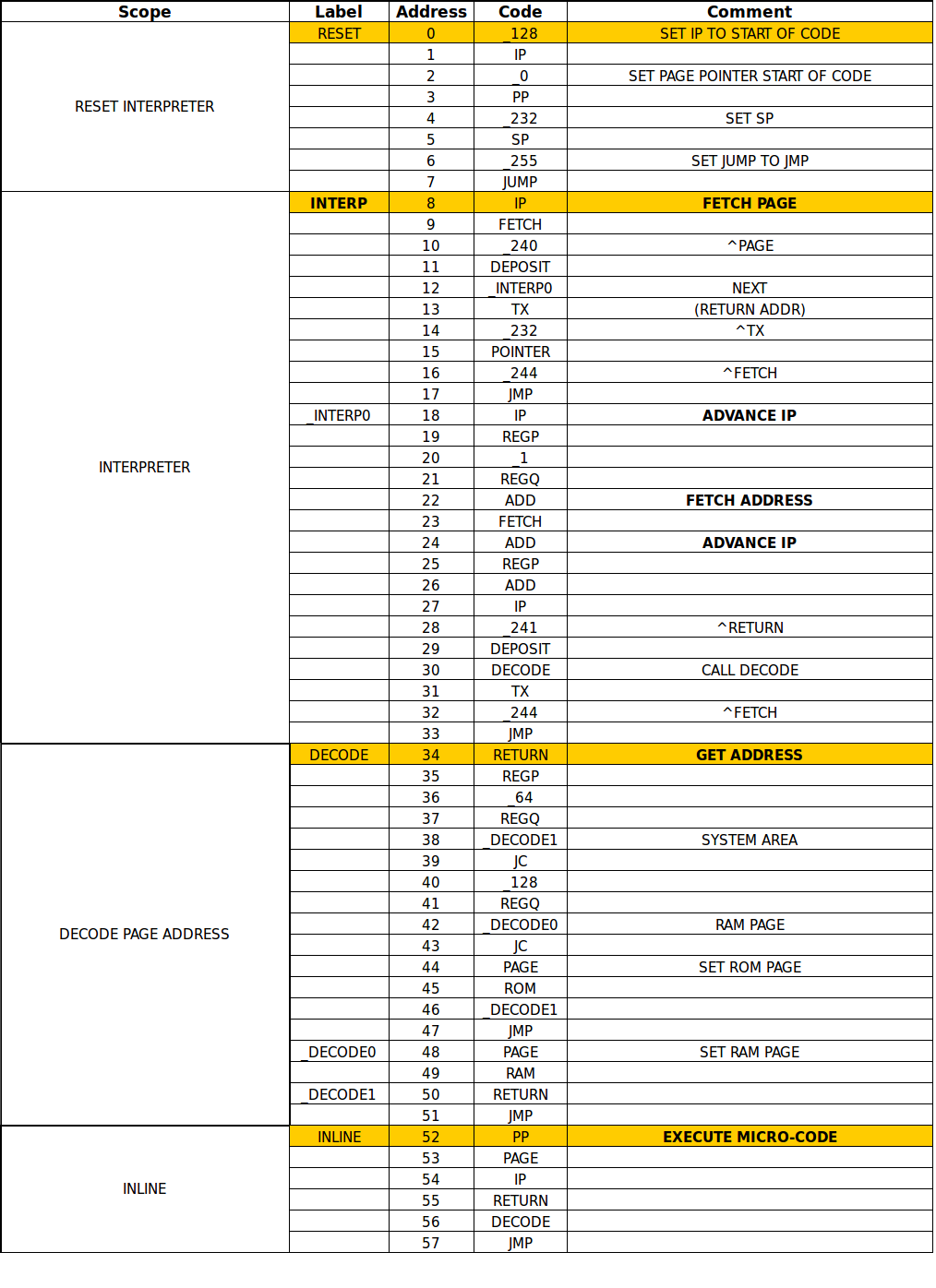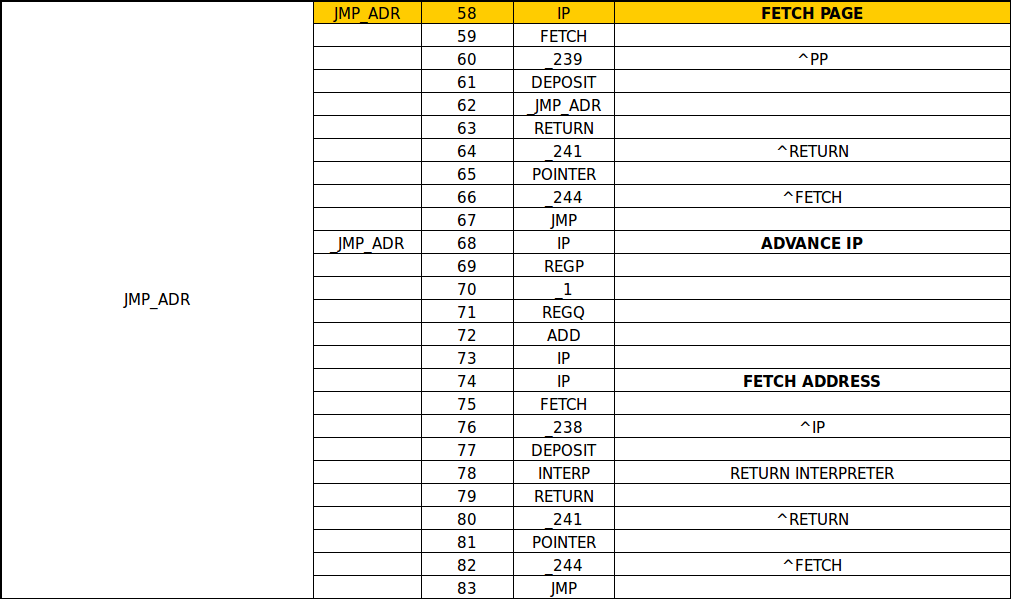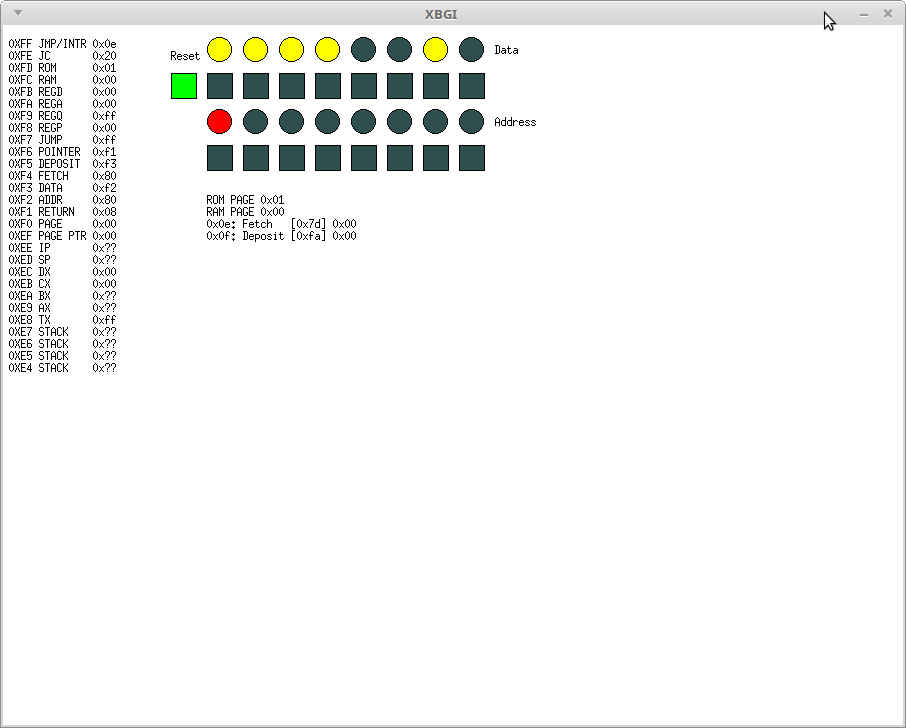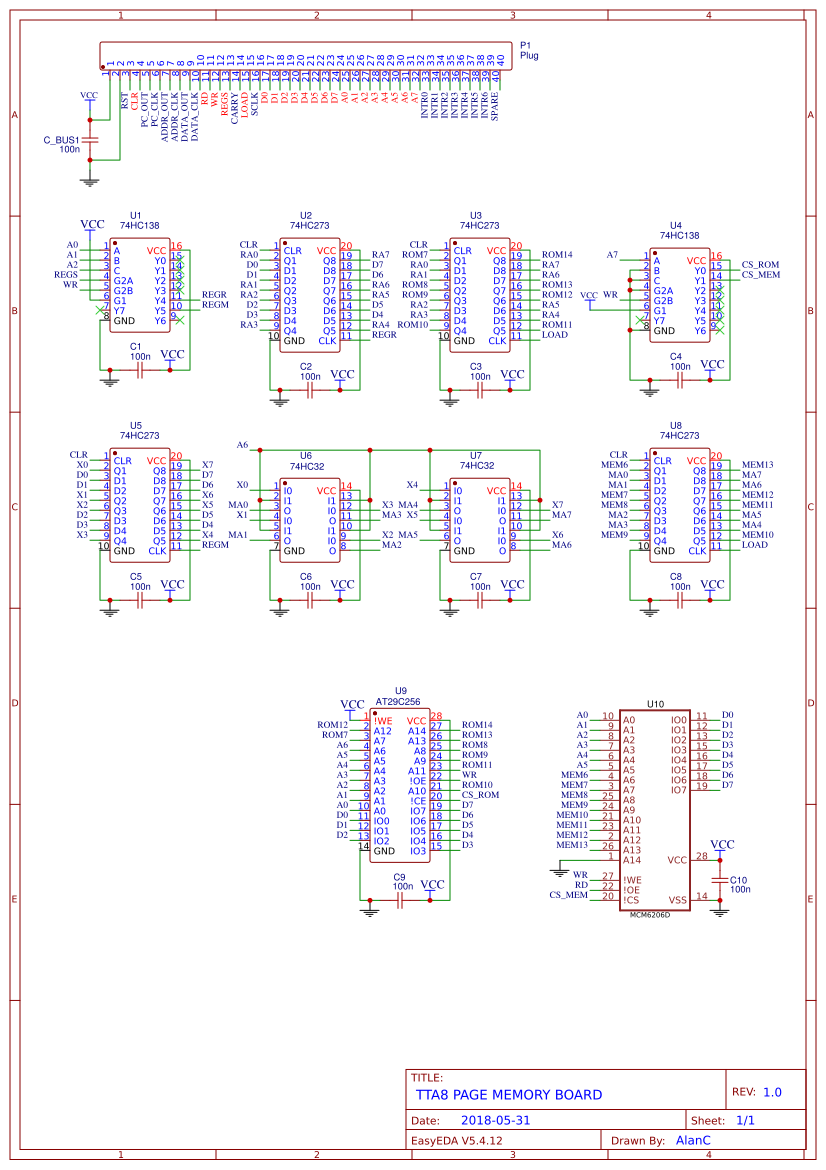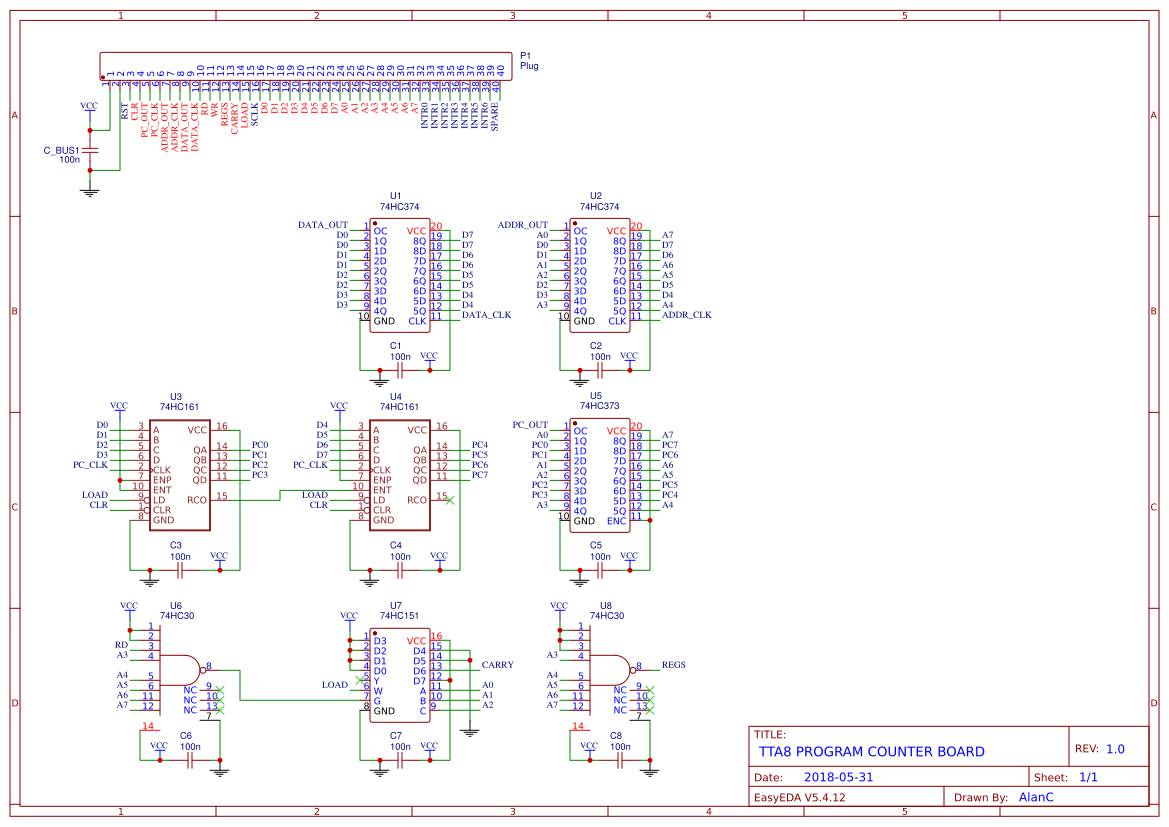-
Almost Working
03/04/2019 at 23:24 • 0 commentsAlmost Working
Updated and tested the Software Data Protection version on the FRAM programmer.
I had set my self a trap! "A14" is not set using SetAddr(), It has its own routine. But it is working now. I have uploaded the code.
Endless Loop
I also wrote a Control Card simulation so I could test the bus. Surprisingly the CPU is mostly working before going into an endless loop.
It fails when I try to change the ROM Page. It should wait until a jump before changing the Page but it changes the Page immediately.
It seems as if the LOAD signal (which signals the PC to jump on the next clock) is glitched.
Using the logic analyzer I did (once) get it to show glitches every write machine cycle.
How to fix?
Cross-talk on the CLR Signal
I am getting about 5 clock cycles on the CLR signal as the Reset triggers reset schmitt trigger. It does not appear to affect (but there is some evidence that it does!) the control circuit. It could be internal cross-talk (as the clock and reset circuity share the same chip) or external cross-talk because the components are close together.
I am thinking of adding a 47 pF capacitor to the input gate of the reset logic.
Next time I will use a 74HC14 rather than build my own Schmitt trigger.
---
The capacitors did not work.
Redesigned the clock and reset circuity.
Redesigned the load signal to avoid the glitch areas between the machine cycles.
Redesigned the boards and sent them off to be made.
Bugger no sooner than I sent the order off I found an error.
Oh well, I will sent the updated board tomorrow.
I am getting close to working!
AlanX
-
Debugging
02/01/2019 at 06:33 • 0 commentsDebugging
Need to get this project working.
One problem is that the Nano does not have enough pins.
So I have used a Meduino (a Mega2560 Pro Mini).
Here is the schematic:
![]()
Here is the PCB:
![]()
The ports (P1 & P2) match the TTA8 bus.
A problem with the Meduino is that pins do not align with the ports (unlike the Nano).
So it is awkward to go fast. Awkward just means more coding. But do I really need to go fast? This time I have coded using pinMode, digitalRead and digitalWrite.
Here is the Mother Board I/O test code:
/* Front Panel Board Test ====================== REGISTERS: Hex Address Write Read Comment FF 255 JMP INTR Jump/Intr FE 254 JC Reserved Jump on Carry FD 253 ROM Reserved ROM PAGE FC 252 RAM Reserved RAM PAGE FB 251 REGD REGD DATA REG FA 250 REGA REGA DATA REG ADDR F9 249 REGQ NAND ALU F8 248 REGP ADD ALU SYSTEM (Pointer to Pointer Copy): Hex Address Write Read Comment F7 247 JUMP JUMP F6 246 POINTER POINTER F5 245 DEPOSIT DEPOSIT F4 244 FETCH FETCH F3 243 DATA DATA F2 242 ADDR ADDR F1 241 RETURN RETURN F0 240 PAGE PAGE CPU MODEL: Hex Address Write Read Comment EF 239 TEMP TEMP EE 238 DELAY DELAY ED 237 INTR INTR EC 236 MASK MASK EB 235 PP PP Page Pointer EA 234 IP IP Instruction Pointer E9 233 SP SP Return Stack Pointer E8 232 DX DX (Monitor Data I/O) E7 231 CX CX (Monitor Addr I/O) E6 230 BX BX E5 229 AX AX E4 228 TX TX Temp Register E3 STACK E2 STACK E1 STACK E0 STACK ... 0xF8-0xFF REGISTERS (8 registers) 0xC0-0xF7 STATIC RAM (56 bytes at page 0xFF) 0x80-0xBF PAGED RAM (64 bytes) 0x00-0x7F PAGED ROM (128 bytes) CPU Emulation: This CPU has no actual opcodes. All instructions are MOVE from [PC] to [PC+1] i.e. Move DATA from source ADDRess to destination ADDRess. The 4 cycles are: 1 Fetch the destination ADDRess pointed to by the program counter and put in the ADDR register 2 Fetch destination DATA pointed to by the ADDR register and put and the DATA register 2A Increment the program counter (PC) 3 Fetch destination ADDRess pointed to by the program counter and put in the ADDR register 4 Deposit the DATA register into the destination pointed to by the ADDR register 4A Increment the program counter (PC) All hardware (PC,IO and ALU) is memory mapped. */ // Board Connections: // Bus Meduino Pin // VCC // GND Gnd #define RST 2 #define CLR 3 #define PC_OUT 4 #define PC_CLK 5 #define ADDR_OUT 6 #define ADDR_CLK 7 #define DATA_OUT 8 #define DATA_CLK 9 #define RD 10 #define WR 11 #define REGS 12 #define CARRY 13 #define LOAD 14 #define SCLK 15 #define Data0 16 #define Data1 17 #define Data2 18 #define Data3 19 #define Data4 20 #define Data5 21 #define Data6 22 #define Data7 23 #define Addr0 24 #define Addr1 25 #define Addr2 26 #define Addr3 27 #define Addr4 28 #define Addr5 29 #define Addr6 30 #define Addr7 31 #define Intr0 32 #define Intr1 33 #define Intr2 34 #define Intr3 35 #define Intr4 36 #define Intr5 37 #define Intr6 38 #define Spare 39 void InitialiseBoard(void) { // Reset State pinMode(RST,INPUT_PULLUP); // Dont care pinMode(CLR,OUTPUT); digitalWrite(CLR,LOW); pinMode(PC_OUT,OUTPUT); digitalWrite(PC_OUT,LOW); pinMode(PC_CLK,OUTPUT); digitalWrite(PC_CLK,LOW); pinMode(ADDR_OUT,OUTPUT); digitalWrite(ADDR_OUT,HIGH); pinMode(ADDR_CLK,OUTPUT); digitalWrite(ADDR_CLK,LOW); pinMode(DATA_OUT,OUTPUT); digitalWrite(DATA_OUT,HIGH); pinMode(DATA_CLK,OUTPUT); digitalWrite(DATA_CLK,LOW); pinMode(RD,OUTPUT); digitalWrite(RD,HIGH); pinMode(WR,OUTPUT); digitalWrite(WR,HIGH); pinMode(REGS,OUTPUT); digitalWrite(REGS,HIGH); pinMode(CARRY,OUTPUT); digitalWrite(CARRY,LOW); pinMode(LOAD,OUTPUT); digitalWrite(LOAD,HIGH); pinMode(SCLK,OUTPUT); digitalWrite(SCLK,HIGH); pinMode(Data0,INPUT_PULLUP); pinMode(Data1,INPUT_PULLUP); pinMode(Data2,INPUT_PULLUP); pinMode(Data3,INPUT_PULLUP); pinMode(Data4,INPUT_PULLUP); pinMode(Data5,INPUT_PULLUP); pinMode(Data6,INPUT_PULLUP); pinMode(Data7,INPUT_PULLUP); pinMode(Addr0,OUTPUT); digitalWrite(Addr0,LOW); pinMode(Addr1,OUTPUT); digitalWrite(Addr1,LOW); pinMode(Addr2,OUTPUT); digitalWrite(Addr2,LOW); pinMode(Addr3,OUTPUT); digitalWrite(Addr3,LOW); pinMode(Addr4,OUTPUT); digitalWrite(Addr4,LOW); pinMode(Addr5,OUTPUT); digitalWrite(Addr5,LOW); pinMode(Addr6,OUTPUT); digitalWrite(Addr6,LOW); pinMode(Addr7,OUTPUT); digitalWrite(Addr7,LOW); pinMode(Intr0,INPUT_PULLUP); pinMode(Intr1,INPUT_PULLUP); pinMode(Intr2,INPUT_PULLUP); pinMode(Intr3,INPUT_PULLUP); pinMode(Intr4,INPUT_PULLUP); pinMode(Intr5,INPUT_PULLUP); pinMode(Intr6,INPUT_PULLUP); pinMode(Spare,INPUT_PULLUP); } bool Reset(void) { byte data; data=digitalRead(RST); if (data==0) { digitalWrite(CLR,LOW); return true; } else { digitalWrite(CLR,HIGH); return false; } } byte ReadAddr(byte addr) { byte data; // SET DATABUS TO INPUT pinMode(Data0,INPUT_PULLUP); pinMode(Data1,INPUT_PULLUP); pinMode(Data2,INPUT_PULLUP); pinMode(Data3,INPUT_PULLUP); pinMode(Data4,INPUT_PULLUP); pinMode(Data5,INPUT_PULLUP); pinMode(Data6,INPUT_PULLUP); pinMode(Data7,INPUT_PULLUP); // SELECT ADDRESS digitalWrite(Addr0,addr&1); digitalWrite(Addr1,(addr>>1)&1); digitalWrite(Addr2,(addr>>2)&1); digitalWrite(Addr3,(addr>>3)&1); digitalWrite(Addr4,(addr>>4)&1); digitalWrite(Addr5,(addr>>5)&1); digitalWrite(Addr6,(addr>>6)&1); digitalWrite(Addr7,(addr>>7)&1); // READ DATA if (addr>=248) digitalWrite(REGS,LOW); digitalWrite(RD,LOW); delayMicroseconds(10); data=digitalRead(Data0); data|=digitalRead(Data1)<<1; data|=digitalRead(Data2)<<2; data|=digitalRead(Data3)<<3; data|=digitalRead(Data4)<<4; data|=digitalRead(Data5)<<5; data|=digitalRead(Data6)<<6; data|=digitalRead(Data7)<<7; digitalWrite(RD,HIGH); if (addr>=248) digitalWrite(REGS,HIGH); return(data); } void WriteAddr(byte addr,byte data) { // SELECT ADDRESS digitalWrite(Addr0,addr&1); digitalWrite(Addr1,(addr>>1)&1); digitalWrite(Addr2,(addr>>2)&1); digitalWrite(Addr3,(addr>>3)&1); digitalWrite(Addr4,(addr>>4)&1); digitalWrite(Addr5,(addr>>5)&1); digitalWrite(Addr6,(addr>>6)&1); digitalWrite(Addr7,(addr>>7)&1); // WRITE DATA if (addr>=248) digitalWrite(REGS,LOW); pinMode(Data0,OUTPUT); pinMode(Data1,OUTPUT); pinMode(Data2,OUTPUT); pinMode(Data3,OUTPUT); pinMode(Data4,OUTPUT); pinMode(Data5,OUTPUT); pinMode(Data6,OUTPUT); pinMode(Data7,OUTPUT); digitalWrite(Data0,data&1); digitalWrite(Data1,(data>>1)&1); digitalWrite(Data2,(data>>2)&1); digitalWrite(Data3,(data>>3)&1); digitalWrite(Data4,(data>>4)&1); digitalWrite(Data5,(data>>5)&1); digitalWrite(Data6,(data>>6)&1); digitalWrite(Data7,(data>>7)&1); digitalWrite(WR,LOW); delayMicroseconds(10); digitalWrite(WR,HIGH); if (addr>=248) digitalWrite(REGS,HIGH); // RESET DATABUS pinMode(Data0,INPUT_PULLUP); pinMode(Data1,INPUT_PULLUP); pinMode(Data2,INPUT_PULLUP); pinMode(Data3,INPUT_PULLUP); pinMode(Data4,INPUT_PULLUP); pinMode(Data5,INPUT_PULLUP); pinMode(Data6,INPUT_PULLUP); pinMode(Data7,INPUT_PULLUP); } void setup() { // Fire up the board InitialiseBoard(); // Serial.begin(9600); // while (!Serial); // Serial.println(); } void loop() { byte A=0; // Check reset button if (!Reset()) { // ADDR LEDs and Switches WriteAddr(0XFA,0X00); A=ReadAddr(0XFB); WriteAddr(0XFB,A); // DATA LEDs and Switches WriteAddr(0XFA,0X01); A=ReadAddr(0XFB); WriteAddr(0XFB,A); } else { // RESET State // ADDR LEDs WriteAddr(0XFA,0X00); WriteAddr(0XFB,0xFF); // DATA LEDs WriteAddr(0XFA,0X01); WriteAddr(0XFB,0xFF); } delay(100); }Testing
Fired up first time! Wow! Okay, I know the Mother Board works.
Here is the reset:
Here is A7:
And D7:
Trust me the rest work.
ALU Board
Next is the ALU Board. It works, no surprise as it tested out before.
ROM/RAM/StaticRAM Board
No it does not work. So far I have found two errors. The ROM page and RAM page are swapped, and the Static RAM (Addresses 192 to 247) are latched (wrong).
I forgot that the ROM/RAM pages are latched by a jump (i.e. JC or JMP).
For testing purposes I can fix these in software but still I cannot read the ROM or RAM data. I have to rework the code to make it easier to log the bus (i.e with a bus analyser).
Still no life out of the board. So the it is a chip select problem. Yes, U4 expects REGS high but I design REGS low.
Fix. I can't fix this in software so time for a new board.
Interrupt Board
This board generates SCLK which is 38400 Hz. It uses the WR signal from the Controller Board. There is always a WR (and a RD) every 8 clock cycles (no more and no less).
Interrupts Intr0 through to Intr6 are external while Intr7 is connected to a 2400 Hz clock (SCLK/16). The interrupt address is 0xFF (read only). Reading the interrupt address clears Intr7. Intr& is used to control the serial card (along with SCLK).
Anyway, my tests tell me the Interrupt/Timing Board is working.
Program Counter Board
This board is controlled by the Controller Board (which previously tested okay (at least by the logic analyzer)).
Other than the Serial Board, this is the last board to test.
New Paged Memory Board
Populated the new Paged Memory Board.
Plug in Mother Board - Fail.
Test the Paged Memory Card:
- Tested Paged RAM - check.
- Tested Static RAM - check.
- Tested Paged ROM:
- Page 0 - Corrupted.
- Pages 1+ - Okay.
Check FRAM in programmer:
- Check - Page 0 correupted.
- Reprogram FRAM
Recheck Paged Memory Card:
- Check - All good.
Plug in Mother Board - Fail.
Test the Paged Memory Card:
- Page 0 - Corrupted.
- Otherwise all good.
This means something is writing to the FRAM as the WR signal is exposed.
Could be code or hardware responsible.
Something to look at tomorrow, otherwise progress has been made.
---I set Software Data Protection (SDP) mode on the AT29C256 FRAM.
At least I think I have? I will find out shortly.
Anyway should not have to reprogram the FRAM after each test.
Now to find out why, is it the Monitor code or a hardware problem?
AlanX
-
Assembled Paged Memory and Interrupt Boards
08/17/2018 at 06:41 • 0 commentsAssembled the Last Two Boards
I will skip the board testing and will code the Monitor to the FlashROM (AT29C256).
You never know I may get lucky.
I designed and build a Nano controlled FlashROM programmer a while back:
Programmer Failure?
I loaded the AT29C256 chip into the stripboard version of my Flash ROM programmer, uploaded my code but it did not work (i.e. load). Stripboard sometimes needs to be cleaned if it has been sitting around for a while. Still no. Found the PCB version of the programmer and still no? Salvaged a known good chip and the programmer was fine. Another bad AT29C256 chip! I have had a few bad chips so I was sort of expecting it.
Loaded the chip into the Page Memory board and no. So I need to test the board.
AlanX
-
Mother Board Tested
07/27/2018 at 08:36 • 0 commentsMother Board Tested
Okay, finally got around to assembling and testing the lastest Mother Board.
All good. Uploaded the Arduino sketch (TTA8_IO_TestWorking.ino) that I used.
---
I have been busy following the Australian "My Healt Record" debacle. It is just amazing how bad politicians lie and how little regard they have for the public.
---
I have more boards that need to be assembled and tested.
ALU Board Tested
You can add the ALU board to the pass list.
The Timing Board passed the logic analyser test previously.
I have double checked the Program Counter Board but it's hard to test so it passed for the moment.
I will assemble the Timer/Interrupt Board next.
Ordered some 74HC273 chips. Should arrive by friday. After that I can assemble and test the Paged ROM/RAM Memory Board. The ROM code is ready, just need to set up the programmer.
I have assembled a Serial I/O Board but testing can wait.
AlanX
-
Another Bad Board
07/05/2018 at 09:10 • 0 commentsAnother Bad Board
I assembled the new Mother Board, hooked up the Nano and no, it did not work.
I had swapped RD and WR signals but still the Data LEDs did not light. Checked the code (worked as expected last time), the hookup and then the schematic. All good, the Nano reports that the Data switches work so it had to be the PCB. Yes, I must have forgotten to update PCB after the last schematic update. The LED Data WR signal is a mess. Its not just a simple jumper.
Oh well, I may as well check all the other boards and get all the corrected PCBs at one time.
Need to do some research on Forth internals as well.
The PC board has a fault as well. Using jumpers for everything means you have to check the jumper labels very carefully.
And more bad boards. Made corrections and sent off for remanufacture.
AlanX
-
More Code
07/04/2018 at 12:33 • 0 commentsAnother Day and More Code Written and Tested
I now have five Interpreter Instructions:
- Inline (for natice micro-code)
- JMP
- JZ (AX==0)
- Call
- RTN
Most the time was spent squeezing the code into a Page.
The code is roughly twice as long as the orginal code written for the unpaged TTA8 (i.e. Weird CPU). But much more difficult to write and test (i.e. more traps to avoid)!
More code to write:
- Push
- Pop
- Load Immediate
- Multiply
- Divide
- etc.
But it would be better to get the hardware going.
Just for the record, here is the counter code:
The current Emlator Version is 9.
AlanX
-
Paged TTA8 Interpreter Conclusion
07/02/2018 at 05:07 • 0 commentsInterpreter Conclusion
The Interpreter is written (and tested) so it is done.
But it is not the end of the Paged TTA8.
This version is much more code expensive than anticipated but still workable.
A non-paged 16 bit version would be much better.
There is still work to complete and test the hardware version.
And to add Interrupts and Serial Communications.
And finally an operating system, perhaps based on Forth.
Added the Interrupt Service Routine
I added support for Interrupts. Each time the Interpeter is called it first checks for an interrupt. Most microcomputers have an address lookup area for storing interrupt service rountine addresses (i.e. it allows software customisation). In my case I just reserved ROM page 3 for ISRs. I will come back to it later (for the serial card).
I also used a timeout on the emulator switches rather than a two clicks (i.e. one on and one off), just a nicety.
I think I have done enough to put together the hardware version of the Paged TTA8.
AlanX
-
Interpreter Up and Running
07/02/2018 at 05:00 • 0 commentsInterpret Up and Running
Some social duties have intervened on my TTA8 work. Today was the first opportunity to spend time on the project.
The Interpreter is now working but it is much bigger (slower) than expected.
Here is the simple version:
INTERP IP SAVE IP POINTER IP INC IC REGP _1 REGQ ADD IP _246 ^POINTER JMP
Here is the Paged version:
INTERP 8 IP FETCH PAGE 9 FETCH 10 _240 ^PAGE 11 DEPOSIT 12 _INT0 NEXT 13 TX (RETURN ADDR) 14 _232 ^TX 15 POINTER 16 _244 ^FETCH 17 JMP _INT0 18 IP ADVANCE IP 19 REGP 20 _1 21 REGQ 22 ADD FETCH ADDRESS 23 FETCH 24 ADD ADVANCE IP 25 REGP 26 ADD 27 IP 28 _241 ^RETURN 29 DEPOSIT 30 _INT1 NEXT 31 TX 32 _244 ^FETCH 33 JMP _INT1 34 DECODE CALL DECODE 35 JMP
Note the Paged Interpreter also calls Decode.
The Counter Program
The counter progrm first sets up the Interpreter and only uses Inline (to revert bck to Machine Code):
![]()
Here is the Interpreter (including Inline and Decode):
![]()
The next Interpreter instruction to write is "JMP_ADR". This will allow jumps to other pages (i.e. it sets the current Interpreter page (PP) and address (IP)). Well actually it has been written just not tested:
![]()
AlanX
-
Version 3 Emulator
06/28/2018 at 10:18 • 0 commentsWhats New?
- Coded a second ROM page.
- The monitor code spans both ROM pages.
- The monitor is both hardware and emulator friendly (i.e. delay rountine added).
- An "Address to Page" decoder routine has been added.
- The Interpreter has been coded but not currently in use.
- The counting demo with delay is machine code.
Version 4
- The Emulater assumes read/write of registers (assumes PCBs will be reworded to suit).
- A bit of a re-organisation the Monitor code.
- Update Reset code.
- Add all the ROM and RAM pages.
- Add code to the Monitor to change RAM pages (uses PAGE PTR), until PCB boards have been updated for register read/write.
- Coded the Interpreter and some support subroutines (ROM PAGE 2).
- Add PP (Page Pointer) to keep track of the Interpreted Page.
- The Interpreter still to be tested.
![]()
The Emulater itself is now pretty complete.
AlanX
-
Second Pass Emulator
06/26/2018 at 11:58 • 0 commentsSecond Pass Emulator
The second pass recoginises the I/O or ports are accessed via:
- REGA - the port address
- REGD - the port read/write
The third pass will add paged RAM and ROM.
Run out of room
Run out of room for the monitor, well I ran out of room a while ago when I "stubbed" the delay routine. Anyway I need to push some code onto ROM page 1 (i.e. the second page).
One of the monitor design "features" was to hide the ROM and RAM page registers from the front panel.
The problem is you cannot manually change the ROM page with monitor running.
The monitor should really have no reason to view the ROM code (on another ROM page) in any case.
Changing the RAM page would be okay, however. But the current design does not allow you to read the page registers and I have no pull ups (or pull down resistors on the Databus. So even changing RAM page is messy.
One way to read/write from/to a register and then copy that register to the RAM page at the end of the monitor rountine. Extra code is the cost for tis patch.
Checking the Page Memory Board schematic:
![]()
I need to add three chips (a decoder and two registers) for a total of 13 chips (crowded).
May be better to split the board into Page ROM and Page RAM.
I should have added pull up resistors to the Program Counter Board:
![]()
It is no big deal, you should not be using the monitor to probe around in this area anyway as it will result in strange things happening as it may interfere with the monitor.
Progress
Anyway, the monitor code is progressing, but ever so slowly.
Version 3 will consider ROM/RAM paging (and require a significant code rework).
Okay I have a plan!
First what was the problem? Oh yeah, two paging systems and how to bring them together for the Interpreter.
Basically an "Instruction Address" has the format:
- Address
- Page
But the Page may be ROM or RAM or the static System area.
The answer is to look at the Address:
- 11XX XXXX System area (registers and static RAM)
- 10XX XXXX RAM Page
- 0XXX XXXX ROM Page
The code would look like this:
POINTER ; Get the Address REGP _64 ; Test if 11xx xxxx (System area) REGQ _EXIT ; Exit if System area JC _128 ; Text if 10xx xxxx (RAM Page area) REGQ _NEXT ; Goto RAM Page JC PAGE ; No, its ROM Page (0xxx xxxx) ROM _EXIT JMP _NEXT: PAGE RAM _EXIT:So expensive for the Interpreter but what choice do I have? Without the issue of Page addressing the Interpret would look like this (5 machine instructions or 10 bytes):
INTERP IP ; SAVE IP POINTER IP ; INC IP REGP _1 REGQ ADD IP _246 ; ^POINTER JMPWith ROM Paging ONLY (no Address decoding) it would look like this (8 machine instructions):
INTERP IP ; SAVE IP POINTER IP ; INC IP REGP _1 REGQ ADD IP IP ; GET ROM PAGE ROM IP ; INC IP REGP ADD IP _246 ; ^POINTER JMPWith Address decoding (17 machine instructions):
INTERP IP ; SAVE IP POINTER IP ; INC IP REGP _1 REGQ ADD IP IP ; GET ROM PAGE PAGE ; PAGE ADDRESS DECODING POINTER ; GET ADDRESS REGP _64 REGQ _EXIT ; SYSTEM AREA JC _128 REGQ _RAM ; RAM PAGE JC PAGE ; SET ROM PAGE ROM _EXIT JMP _RAM PAGE ; SET RAM PAGE RAM _EXIT _1 ; RESTORE REGQ REGQ ; CONTINUE WITH INTERPRETER IP ; INC IP REGP ADD IP _246 ; ^POINTER JMPIf you find the code above incomprehensible then you can understand why micro-coding is so slow and why an Interpreter is so important.
AlanX
8 Bit TTA Interpreter
TTA (Transport Triggered Architecture) is very simple CPU type.
 agp.cooper
agp.cooper